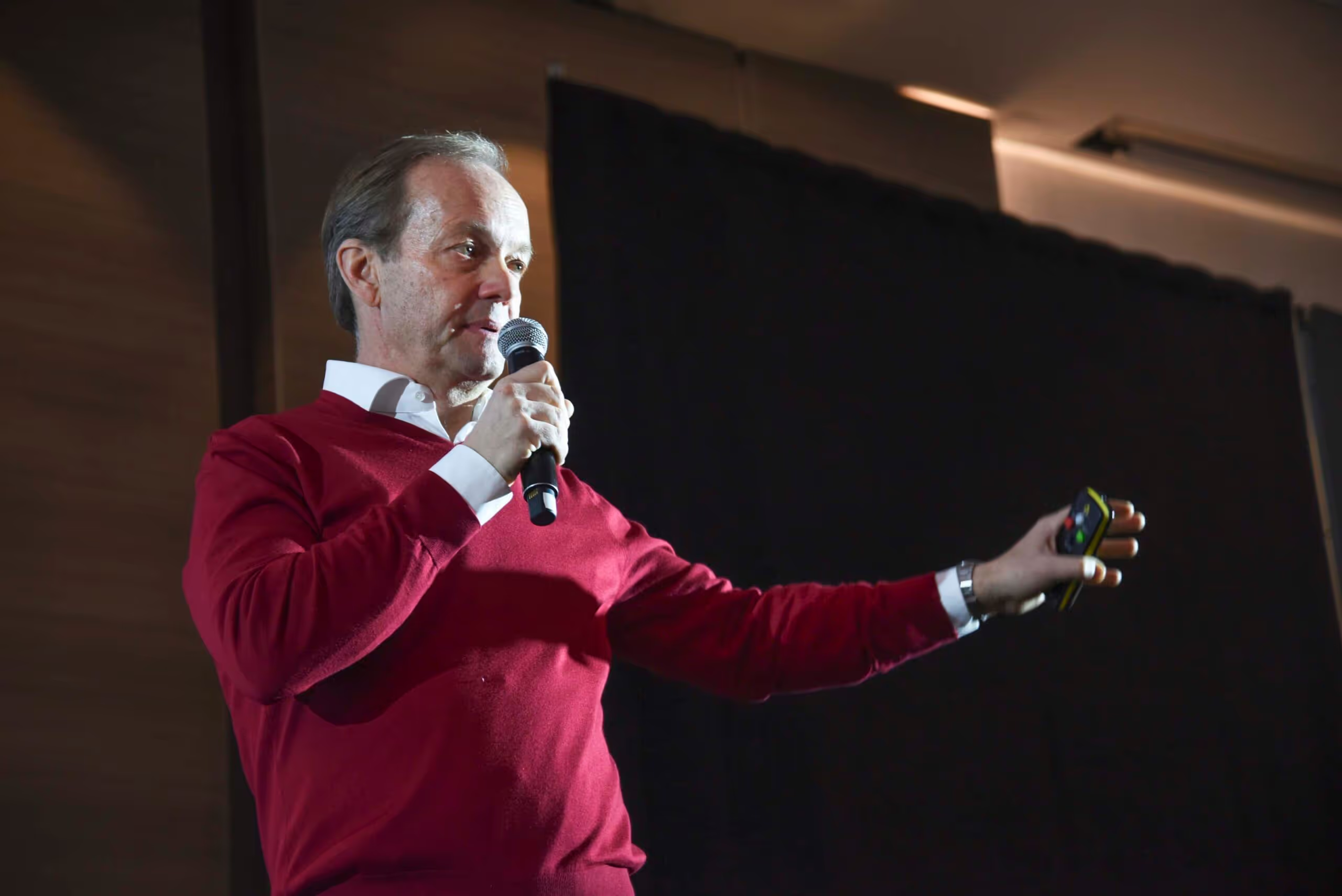In-person events are back — here are 4 steps to improve the planning process

This blog is based on an article that was originally published in SUCCESS. It has been updated for 2025 and beyond
Large-scale events like sales kickoffs and leadership summits have long been a staple of business strategy. They’ve served as annual milestones—moments to align, inspire, and energize teams around the path forward.
But in today’s environment, their role has become even more vital. As organizations navigate dispersed teams, shifting strategies, and relentless change, these events are no longer just ceremonial—they’re one of the few chances to create clarity, connection, and culture at scale.
How you bring people together is now just as important as why.
Virtual fatigue, rising costs, evolving team structures, and hybrid expectations have transformed event planning from routine to strategic. The most effective companies are moving beyond default formats and asking: What does this moment demand—and how do we design for it?
There’s no one-size-fits-all anymore. The best events flex—tailored to your business, your people, and the outcomes that matter most.
So is there a gold standard? In-person still delivers unmatched energy and connection—but in 2025, the smartest strategies are context-driven.
- In-person builds energy you can feel. It’s unmatched for connection, culture, and rallying teams around big shifts.
- Hybrid expands reach. It connects distributed teams while maintaining presence and participation.
- Virtual is fast, inclusive, and cost-effective—perfect when timing or accessibility is the priority.
- Hyper-local brings people together in smaller, regional gatherings—minimizing travel while maximizing face time and relevance for specific markets or teams.
The question isn’t which format is best—it’s what does this moment call for?
This updated post explores how to design high-impact events—tailored to your context, your people, and your goals.
Let’s dive in.
Set the tone—and build something that lasts
It’s not just the format that’s shifting. Structure, length, content, and tone are evolving too—which creates a powerful opportunity for leaders to shape more meaningful, memorable experiences.
To make these moments count, it helps to pause and consider:
- What do you want this experience to be remembered for?
- How do you want people to connect with it—and with each other?
- What kind of follow-through do you want to inspire?
Approaching event planning through this lens turns it from a one-off activation into a long-term investment. As a leader, you don’t have to manage every detail—but you do need to set the tone. When your vision is clear, your team can build something truly intentional.
Here are four strategies to help you get there:
1. Empower teams to make the right decisions.
Many meetings are unproductive or a waste of time, and meetings involving event coordination may become nothing more than project updates. Though these aren’t without merit to gauge progress, it shouldn’t be the sole focus. For execution teams to act on the right decisions around every detail, the meeting agenda should also touch on the vision, benchmarks, next steps and any obstacles that might require additional support, among other topics. And it should do so at a cadence that makes sense for you, the team and the event itself.Perhaps all that’s necessary is to meet once a month until the event date closes in. Maybe every two weeks is a better option. Information is power, as they say, and you can empower your team to take initiative on their own. Research has shown that empowering team members may lead to innovative behavior and improved work performance, among other benefits. This potential boost to innovative, proactive and knowledge-sharing behaviors may be especially useful when it comes to the team developing innovative ideas and the wherewithal to put those ideas into action. Engage all team members early in the planning process. Provide them with the freedom necessary to make decisions on their own so that when things deviate from the plan, they can adjust accordingly instead of being left unsure of the next steps.
2. Find a balance between internal vision and external engagement.
You’re essentially building a legacy for how you want to be remembered. This can have a sizable impact on not only creating a memorable and lasting experience for your audience, but encouraging them to return year after year.Just look at the Consumer Technology Association’s CES® event, which claims to be “the most influential tech event in the world.” At this year’s event, CES welcomed nearly 120,000 attendees from around the world and offered massive visibility (print and social media) to its exhibitors and presenters. The planning and execution of this event, which showcases other companies’ solutions, requires months of vetting potential exhibits, working with venue and event teams and organizing high-profile keynotes.While staying true to your vision is critical, make sure that you don’t lose sight of the customer in the process. Get boots on the ground and make a habit out of listening, relaying what’s learned and even following up with customers. Then, it’s just a matter of striking a balance between your vision for the event and what the audience is saying. It’s important not to go too broad or too narrow when homing in on your audience and vision; it’s more about finding something in between that speaks to what’s really going on in the business and what attendees want in an event.
3. Create a purposeful, intentional atmosphere for meetings.
All discussions should be connected to the company strategy—“connected” being the operative word here. Think about the purpose and desired outcome. What conversations do you need to initiate? What is the red thread or throughline for everything you’re doing at the event?Without that connection, the focus can shift away from the strategy. Our company uses a pyramid diagram to divide ideas into sections and organize the meeting structure to ensure all discussions are intentional and purposeful.At a recent sales kickoff for a large client, we ensured the client’s new methodology and customers were at the core of every design element. Everything from the digital solution to the scenarios that participants engaged in to how facilitators led debrief conversations was designed to reinforce the new methodology and drive the effectiveness of a cross-functional team in service of customers. As a result of that intentionality, the client saw a 54% uplift in their pipeline coming out of the event and a 40% adoption growth of a newly introduced scorecard for account executives.
4. Reflect on operational successes and failures.
You may not think of reflection as a competency, but research shows that such a habit can be the differentiator between extraordinary and mediocre workplace performance and engagement, and it may serve to benefit your team as well. As such, make after-event discussions more than just debriefing sessions. Did the experience lead to the desired outcomes? Were there any unanticipated outcomes? More importantly, how do you plan to track results over the next few weeks or months?Our company worked with one client who was exceptional at this process. Naturally, the event’s theme fed into the experience from start to finish, and the outcomes were as expected. But instead of checking off that box and returning to business as usual, the client took reflected on the outcomes. They found ways to incorporate that specific experience into their organization so they didn’t lose any traction made with the target audience.
Thinking more strategically about how to execute an event and incorporating these event planning tips will put you a step ahead of the competition. It will also help you create an experience that’s both memorable and a critical part of establishing a legacy for you and your company.
Related content

5 mistakes senior leaders make when presenting to other senior leaders
Heading 1
Heading 2
Heading 3
Heading 4
Heading 5
Heading 6
Lorem ipsum dolor sit amet, consectetur adipiscing elit, sed do eiusmod tempor incididunt ut labore et dolore magna aliqua. Ut enim ad minim veniam, quis nostrud exercitation ullamco laboris nisi ut aliquip ex ea commodo consequat. Duis aute irure dolor in reprehenderit in voluptate velit esse cillum dolore eu fugiat nulla pariatur.
Block quote
Ordered list
- Item 1
- Item 2
- Item 3
Unordered list
- Item A
- Item B
- Item C
Bold text
Emphasis
Superscript
Subscript

Face Your Fears and Make Your Workplace Better
Heading 1
Heading 2
Heading 3
Heading 4
Heading 5
Heading 6
Lorem ipsum dolor sit amet, consectetur adipiscing elit, sed do eiusmod tempor incididunt ut labore et dolore magna aliqua. Ut enim ad minim veniam, quis nostrud exercitation ullamco laboris nisi ut aliquip ex ea commodo consequat. Duis aute irure dolor in reprehenderit in voluptate velit esse cillum dolore eu fugiat nulla pariatur.
Block quote
Ordered list
- Item 1
- Item 2
- Item 3
Unordered list
- Item A
- Item B
- Item C
Bold text
Emphasis
Superscript
Subscript

Henrik Ekelund Selected as One of Five Finalists
Heading 1
Heading 2
Heading 3
Heading 4
Heading 5
Heading 6
Lorem ipsum dolor sit amet, consectetur adipiscing elit, sed do eiusmod tempor incididunt ut labore et dolore magna aliqua. Ut enim ad minim veniam, quis nostrud exercitation ullamco laboris nisi ut aliquip ex ea commodo consequat. Duis aute irure dolor in reprehenderit in voluptate velit esse cillum dolore eu fugiat nulla pariatur.
Block quote
Ordered list
- Item 1
- Item 2
- Item 3
Unordered list
- Item A
- Item B
- Item C
Bold text
Emphasis
Superscript
Subscript

